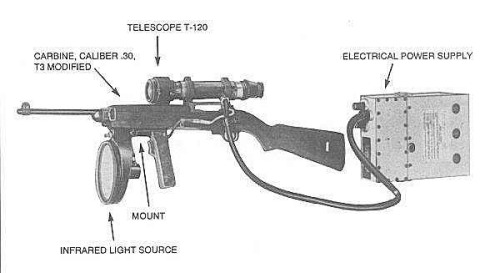The T3 Carbine,Introduced at the end of World War II, the T3 carbine was a variant of the M2 Carbine
The T3 Carbine,Introduced at the end of World War II, the T3 carbine was a variant of the M2 Carbine (a fully automatic M1 carbine with a 30 round magazine) outfitted with a state of the art infrared light source and scope. The system worked by emitting infrared light from an infrared light spotlight. With the naked eye infrared light is invisible, but with an M2 infrared detecting sniper scope, the users would have a modest degree of night vision up to 70 yards. All of this equipment would have been powered by a large battery pack. Later, the system was upgraded with a new scope that enhanced night vision up to 100 yards, and even later up to 125 yards. Typically a three man crew was deployed to operate the T3, with one acting as gunner, and another two acting as spotters and managing the T3’s complex systems.The T3 carbine was first deployed in combat at the Battle of Okinawa, where it became important in prevent Japanese soldiers from sneaking up on enemy lines at night. It was during the Korean War that the T3, then known as the M3 carbine, would see its most prolific use, being used by night sentries to prevent North Korean and Chinese forces from conducting night attacks. By the end of the Korean War, M3 carbines were outfitted with a forward grip. After the Korean War, new weapons and new night vision systems would make the T3 and M3 carbine obsolete. They saw some use in Vietnam, although by then more advanced night optics came into use. Around 3,000 T3 carbines were produced. -- source link
Tumblr Blog : peashooter85.tumblr.com
#guns#firearms#weapons#wwii#korean war#history#carbines


